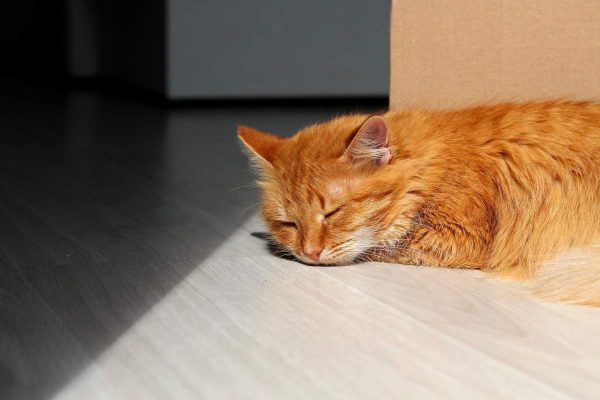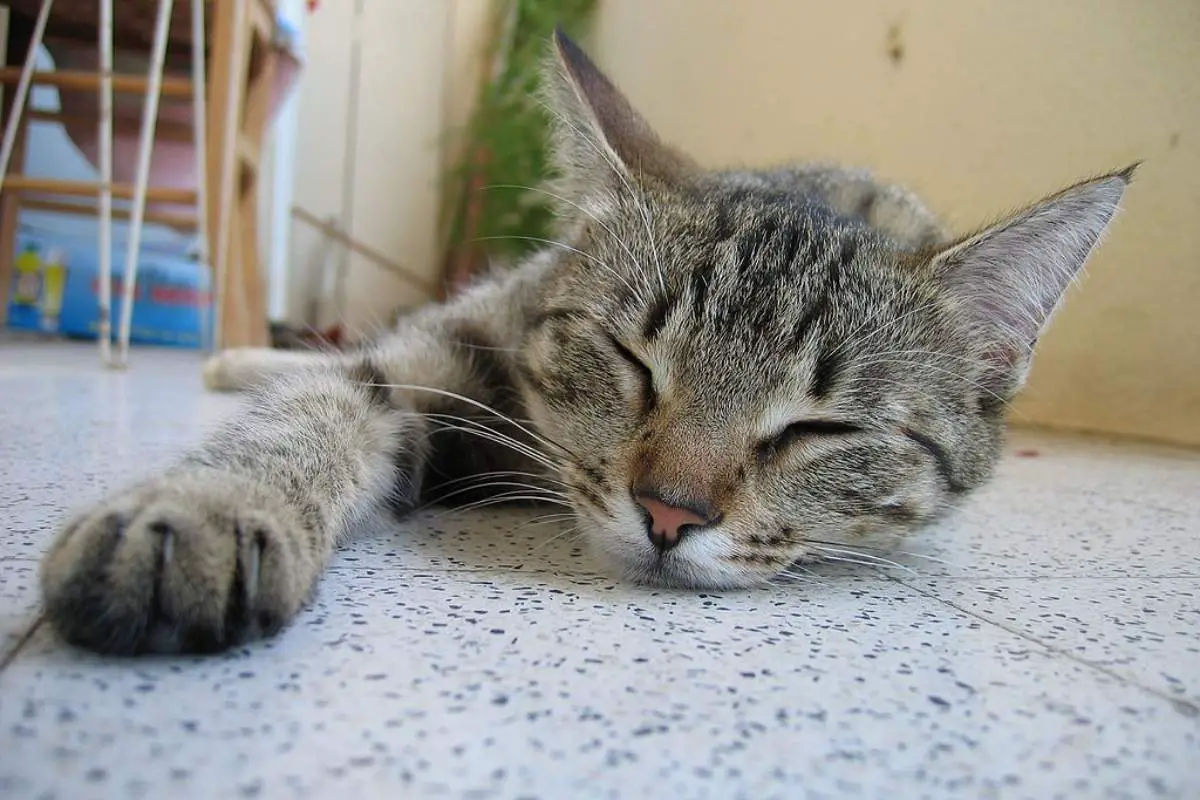A yawning, sunbathing cat is the picture of relaxation and contentment. At intervals throughout the day, the independent housecat will take brief naps, curling their paws underneath themselves or stretching out their long bodies. It can amuse the owner, sometimes, to see their pet choosing to take their snooze on the ground rather than a couch or other seemingly more comfortable surface.
So, why does my cat sleep on the floor? Cats can prefer to nap on the ground because of their instincts. Being comfortable in their conquered territory, preferring the cool surfaces of lower levels, or feeling too bodily strained to jump or climb could all be factors in your feline’s napping locations.
Let’s examine how to determine if your cat’s nap space is just for comfort, or if there’s something wrong that you need to tend to. Being aware of your pet’s joint health, temperature levels, or other preferences is important to ensuring that their unlikely sleep spot isn’t an indicator of a deeper issue.
Ancestry

A domestic pet cat still has biological roots with wild cats stalking the jungles and woodlands. Part of those ancestral codes are telling your kitty that they want to stay on the move. Once they’ve claimed territory in your shared home, they feel comfortable to set up camp for their rest anywhere within those parameters.
However, sleeping in the same space every time will leave them predictable and thereby vulnerable to predators. That instinct for survival forces them to try new areas for rest every once in a while so they don’t leave their scent too strongly in any one area.
Cats spend much of their energy with pouncing, leaping, batting around items, or climbing. All these activities require a burst of energy that can deplete them rather quickly, requiring them to take pretty frequent rests throughout the day. As the historically top predator, your ferocious feline can afford to take his or her cat naps to recharge for another round of leaps and bounds!
Temperature
If you notice your cat dozing on primarily cool floors like tile, shaded wood, or concrete, your cat might be experiencing heightened body temperatures and seeking a place to cool down.
An outburst of play and energy might have them a little warm, or they could be having a hard time cooling down. Cat’s sweat through glands in their paws, and heat leaves them through their ears, so it takes a good deal of time for them to cool off. If their body temperature is too high, they can be quite uncomfortable and seek a shaded or chilled place to doze. If your cat is too hot, you might notice:
- Pacing or agitation
- Restlessness or a raised heart rate
- Panting, red tongue
- Lethargy
- Stumbling or balance issues
You can adjust the temperature in your home, purchase a cooling pad, or keep their food and litter on cooling tile floors to give your cat a space where they can retreat if they are uncomfortable.
Claimed Territory

The primal part of your pet adds to their trademark aloofness. Cats parade around the house knowing that it’s their kingdom.
Cat’s can mark their territory with rubbing and scratching to get their bodily scent in the area. They prefer areas with bountiful opportunities for mental stimulation, and you might notice them making entertainment out of non-traditional items and spaces, like getting stuck in small gaps or scratching up your furniture.
Once a cat has claimed, marked, and made themselves comfortable in their territory, they feel free to completely let their guard down and plop themselves just about anywhere to sleep or relax.
This could be rather inconvenient for you, as they might pose a fuzzy tripping hazard, but it’s completely natural for them. In their minds, they now rule the roost, so it’s fair game to make their bed in the dead center of your room.
Arthritis
As your cat ages, it might start to experience pain and aching in it’s joints. Cartilage deterioration is normal in aging animals, and that can begin to put more pressure on the joints and muscles they use to jump and climb. Once it becomes painful for them to pounce up to high places, you might notice them gravitating to lower nap spots, preferring to snooze on the floor rather that go through the discomfort of trying to climb.
When you notice the telltale signs of arthritis in your cat, you can try the following:
| Symptom: | Aid: |
| Refusing handling | Plenty of blankets padding their preferred places to lay |
| Lethargy | A change in diet or visit to the vet to make sure it’s not symptomatic of a deeper issue |
| Weak, thin muscles | Easier access to their food and water within walking distance |
If your aging cat is consistently preferring the ground, it’s possible that they have a medical reason, and they might need some additional aid.
When your cat gets older, you could see it starting to experience changes in his weight and balance as well. Both of those things could also keep your cat closer to the ground. A simple change to diet, or nutritional supplements, can help regulate your cat’s body composition as they age and change. Even old kitties need tender loving care, and making them comfortable is every owner’s intention.
Position

Your cat’s sleeping position might give you a clue about what they’re thinking and feeling. If you notice your kitty sprawled out on the ground in a specific posture, you might be able to determine why they’re so comfortable down there!
Stretched on Their Side
A cat that is laying long and lean on its side is relaxed and content. They don’t feel the need to stay alert, so you can believe that they are safe and happy.
Sphynx Pose
If your pet is napping upright with their paws tucked underneath them, they are happy and unagitated. If they thought they might need to quickly leap to their feet, they wouldn’t lay on top of them, so your cat is showing you that they are relaxed.
Sprawling
When you see your cat laying on their back with their legs all spread out, your cat is feeling confident. Exposing their belly could leave them vulnerable, but there they lay, showing you that they fear nothing in that moment. However, their feet and claws are readily available, so don’t touch that sleeping belly, or you’ll learn your lesson!
Scent
Though they might not look like a bloodhound, cats are very sensitive to smells, so much so, that a cat can reject a perch because of a scent so slight that it’s imperceptible to a human nose.
If you see your cat sleeping on the floor, it might be because the couch or chair could have a smell they don’t like.
Take a moment to consider what scent they could be sensing. Pungent detergents, fabric softeners, or clearing products can leave a smell or a residue that’s displeasing to your kitty. Cats are also known to strongly dislike the smell of citruses: lemon, lime, grapefruit or orange.
It could be possible that a cleaning product or room fragrance could have settled in the soft surface of a bed, couch, or cushion, and now it’s off limits for your pet’s sensitive nose!
Unfortunately, many air fresheners are scented with common flavors like lavender, rosemary, cinnamon, or pine, etc. It’s possible that your cat has an aversion to one of those smells, and it’s presence is keeping them away from other nap spots. If that’s the case, they’ll just prefer to sleep on the floor.
You Know Your Pet!

This furry friend is a part of your family, and you know them best. Don’t be alarmed if your cat sleeps on the floor; it could be any combination of harmless factors, or an indicator of something else you should be watching.
Maybe they’ve slipped and fallen when they tried to jump, and now they’re afraid of some taller perches! Perhaps they like the cool, smooth floor, or warm textured carpet! Regardless, your cat can be more picky than you might think.
Why Does My Cat Sleep on the Carpet?
Cats may choose to sleep on the carpet for various reasons. Firstly, carpets often provide a soft and comfortable surface that appeals to their need for a cozy resting spot. Unlike harder surfaces, the carpet’s texture can be soothing for a cat’s paws.
Additionally, cats are known to regulate their body temperature through their surroundings, and carpets can offer a warmer surface compared to cooler alternatives. Some cats might have had negative experiences or slips on other surfaces, making the carpet a safer and more secure choice.
If you find yourself wondering, do cats like sleeping on the floor? the answer may vary, but the soft and comforting texture of carpets could certainly be a factor in their choice of a preferred sleeping spot.
Conclusion
Your cat will take many naps throughout the day, and noticing those locations can give you critical insight into their minds and preferences. Watch your kitty’s body language during these dozes to determine it’s mood or comfort level, or pay attention to his energy and pain to see if perhaps these floor naps are indicative that your cat could need you to make changes around the home.
